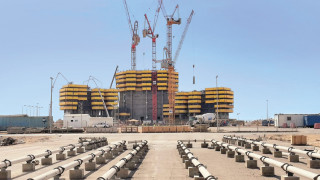It’s been a busy year for the UK construction industry and the general air of optimism around now suggests that 2016 will be busier still.
For the first four months of the year, much of the talk was about the forthcoming general election and how the outcome might affect industry workloads.
It’s normal for things to slow down markedly in the run-up to an election as contract awards are deferred and start dates put on hold until the political dust has settled. But for some reason this year, the industry ploughed ahead regardless; our monthly Contracts League showed the work continuing to flow with almost £5bn-worth of contracts let in April.
The industry’s apparent insouciance was also reflected in the traffic passing through The Construction Index website. Nothing remotely connected with the general election features in the 100 most frequently-viewed news stories on our website during 2015.
Instead, visitors to theconstructionindex.co.uk seem more interested in off-the-wall engineering projects and the colour of traffic cones.
Of course, serious topics such as health & safety, workload fluctuations and corporate upheavals always attract a good deal of attention – after all, that’s the sort of thing you expect a business-to-business publication to report.
So perhaps it’s no surprise that the most widely-read news story of 2015 was that quarry firms and hauliers were blaming politicians and policy-makers for a sudden increase in accidents involving heavy goods vehicles.
The story broke in February following an incident in Bath in which a young girl and three adults were killed when an 18-year-old driver lost control of a 32-tonne tipper truck full of gravel.
The British Aggregates Association pointed out that a decision to apply the Working Time Directive to road haulage had led to a mass exodus from the industry of experienced owner-drivers whose earnings had plummeted along with the reduced hours.
The subsequent decision to compensate for a shortage of drivers by lowering the minimum age for an HGV licence from 21 to 18 had led to an influx of young and inexperienced drivers.
The industry’s outcry seems to have fallen on deaf ears, however. The minimum age remains 18 and although the EU drivers’ hours regulations were relaxed during the summer, this was only an emergency measure to cope with disruption to cross-Channel commercial traffic caused by strikes at the Port of Calais.
Bad news always attracts attention and, in an industry that consistently tops the league table of company insolvencies, it’s no surprise that when news broke that PC Harrington Construction had called in the administrators, Construction Index readers sat up and took notice. This was our second most-read story of the year.
News of PC Harrington’s difficulties were especially gripping because not only had the company been involved in some of the most high-profile building projects of recent years (the Gherkin, Walkie-Talkie tower and the new Wembley Stadium among them) but it had always kept a very low media profile and there was no hint of trouble in store. News that it was going under came as a shock.
So too did news, just a few weeks later, that GB Group – the contractor created in 2005 from a management buyout of the building divisions of Gleeson – was also in administration.
Despite the obvious impact of such business failures, visitors to the Construction Index website seem to actively seek out – and share on social media – good news stories, especially those focusing on technical innovation.
The third most-visited news story of the year was about the record-breaking Meccano bridge built by civil engineering students at Queen’s University, Belfast.

It seems that just as a Meccano set can bring out the civil engineer in any nine-year-old, it can just as easily bring out the nine-year-old in a fully-grown civil engineer. Who, as a child in possession of a box of Meccano, did not dream of building a bridge big enough to carry their own weight? This was the sort of story that’s guaranteed to get professional designers and engineers wistfully recalling childhood construction projects magically free of irritations such as client variations, accelerated programmes and liquidated damages. Readers were sufficiently inspired by this story to give it 739 ‘likes’ on Facebook, making it the second most popular story referenced on social media.
However, the story that got the most Facebook ‘likes’ (and makes this year’s tally a baker’s dozen) was not even among the 50 most-visited stories on the Construction Index site. This was a report on new research, published in the Institution of Civil Engineers journal Bioinspired, Biomimetic and Nanobiomaterials, into how owls manage to fly so silently.


Scientists as Dalian University of Technology in China found that owl feathers are constructed in such a way that they absorb noise caused by vibrations during flight. The big deal for construction engineers is that this could yield clues to help us make wind turbines much quieter.
Cutting-edge (and just plain odd-ball) technical stories like this proved very popular this year. A big favourite – and the story that got the fifth-largest number of hits on the website – was a barely credible story about a new type of road surfacing that acts as a giant solar panel.
Wacky though it sounds, this product, called Wattway, has been developed by leading roads specialist Colas and not only has two patents protecting it but has been installed in a couple of trial installations.
It’s certainly an intriguing concept. Colas says that Wattway is extremely sturdy, skid resistant and able to bear the weight of heavy traffic and that 1km of the product would generate enough energy to power the streetlights for a town of 5,000 inhabitants.
The story generated a lot of dialogue on social media too, becoming the most-shared story on LinkedIn, being shared 285 times.

Not all clever innovations are as high-tech as this, though. Almost as popular as the Wattway story this year was a report of another road-oriented product development: green and yellow traffic cones.
We’re all used to seeing bright orange traffic cones, aren’t we? But two site workers at EnterpriseMouchel – Colin Seager and Clive Stears – had a collective brainwave and realised that colour-coding your traffic cones could help direct traffic more safely and effectively.
Hence the green cone (to indicate the entrance to work sites from live carriageways) and the yellow cone (to alert workers to the proximity of live overhead power lines. The best ideas are often the simplest.
Still on the theme of technical novelty, a report in September describing concrete placement on what is expected to become the world’s tallest building, the Kingdom Tower in Jeddah, attracted a lot of interest and was shared 275 times on LinkedIn, second only to the Colas story.

Several high-power Schwing concrete pumps are being used to pump a special high-performance self-compacting concrete for the tower, which will rise to a height in excess of 1,000m.
Less awe-inspiring, but of more immediate concern to UK-based readers was another technical concrete story. This was the revelation by Highways England (successor to the Highways Agency) that the concrete barriers installed on Costain’s £225m contract to upgrade the M1 between junctions 28 and 31 were infected with contaminated concrete.
The offending mix, supplied by Lafarge Tarmac, contained calcined dolomite – burnt or partially burnt limestone that expands when wet and causes the concrete to spall and crack. By the time the story broke, Costain was already carrying out “significant” remedial works.
Readers are naturally always interested in hearing about new work opportunities coming on-stream, and in 2015 one of the most talked-about sources of future employment was the proposed Hinkley Point C nuclear power station.
A report in July generated a buzz of excitement when a Balfour Beatty/NG Bailey joint venture landed a £460m contract for the electrical package on the project.
Up to £840m-worth of additional contracts were also lined up by client EDF at the same time, promising bountiful opportunities for contractors and suppliers further down the supply chain.
Strangely, the only other contract awards story to feature in the Construction Index Top 12 stories of 2015 was a relatively modest, £80m, housing scheme for Weston Homes in Dartford, Kent.
House-building, of course, has remained the most virile sector of the industry since at least 2012. Weston’s Mill Ponds development is certainly a decent tranche of work for local contractors but compared with Hinkley Point, it’s a drop in the ocean.
Got a story? Email news@theconstructionindex.co.uk



